Electrical resistance of certain materials, known as superconductors, changes abruptly from a nonzero value of zero as their temperature is lowered below a critical temperature TC(0). An interesting property of super conductors is that their critical temperature becomes smaller than TC(0) if they are placed in a magnetic field, i.e., the critical temperature TC(B) is a function of the magnetic field strength B. The dependence of TC(B) on B is shown in the figure.
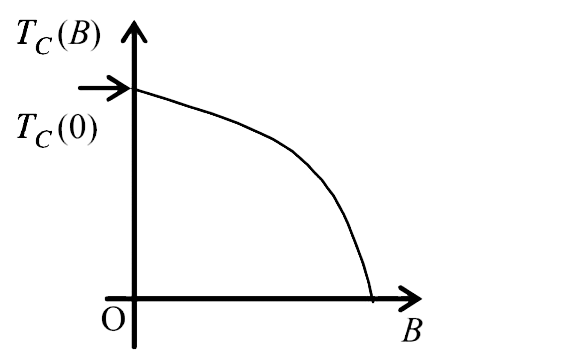 .
.
In the graphs below, the resistance R of a superconductor is shown as a function of its temperature T for two different magnetic fields B1(solid line) and B2 (dashed line). If B2 is larget than B1 which of the following graphs shows the correct variation of R with T in these fields?
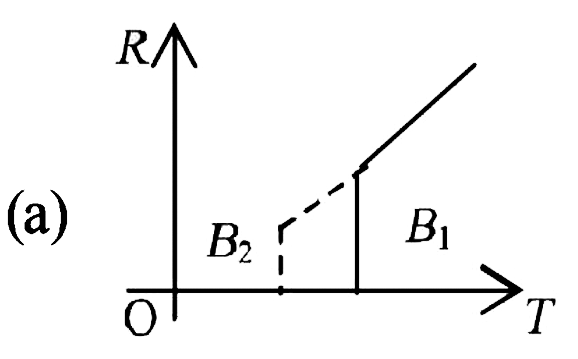
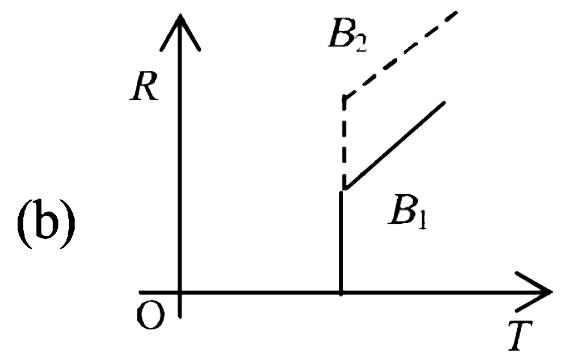
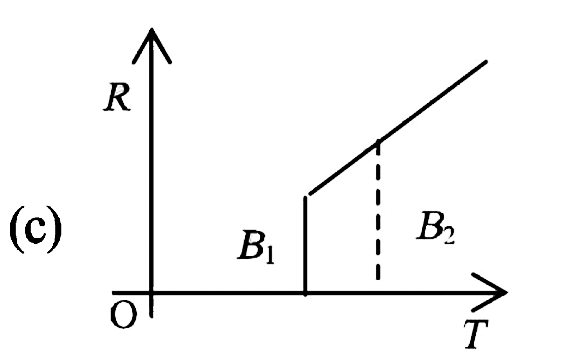
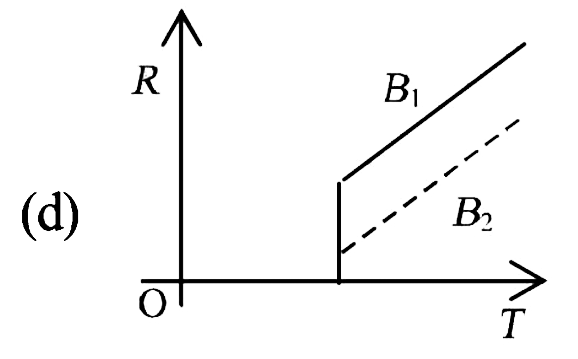
The correct Answer is:A
(a) From the given graph it is clear that with increase of the magnitude of magnetic field (B), the critical temperature TC(B) decreases.
Given B2>B1. Therefore for B2, the temperature at which the resistance becomes zero should be less. The above statement is true for graph (a).
Topper's Solved these Questions
Similar Questions
A uniform wound solenoidal coil of self inductance 1.8×10−4 henry and resistance 6 ohm is broken up into two identical coils. These identical coils are then connected in parallel across a 15-volt battery of negligible resistance. The time constant for the current in the circuit is.......seconds and the steady state current through the battery is ..............amperes.
View SolutionElectrical resistance of certain materials, known as superconductors, changes abruptly from a nonzero value of zero as their temperature is lowered below a critical temperature TC(0). An interesting property of super conductors is that their critical temperature becomes smaller than TC(0) if they are placed in a magnetic field, i.e., the critical temperature TC(B) is a function of the magnetic field strength B. The dependence of TC(B) on B is shown in the figure.
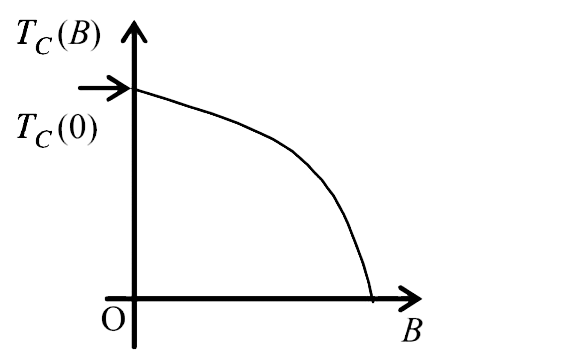 .
.
A superconductor has TC(0)=100K. When a magnetic field of 7.5 Tesla is applied , its TC decreases to 75 K. For this material one can difinitely say that when
View SolutionAt which of the following conditions can a gas be liquified? Tc and Pc are critical temperature and pressure.
View SolutionWhich of the following gases has the least value of critical temperature (T_(c )) and critical pressure (p_(c )) ?
View SolutionCritical temperature (TC) will be maximum for the following gas ?
View SolutionThe temperature 30.98^(@)C is called critical temperature (T_(C)) of carbon dioxide. The critical temperature is the
View SolutionSelect the correct order of the following temperature: {:("Boyl tempe.","Critical temp.","Inversion temp.",),(" "T_(B)," "T_(C)," "T_(I),):}
View SolutionWhich of the following relation is correct ?
(where Ti = Inversion temperature, Tc = Critical temperature)
View SolutionIn following isothermal graphs A, B and C at temperatures T_(1), T_(2) and T_(3) , the correct order of temperatures will be :
View SolutionElectrical resistance of certain materials, known as superconductors, changes abruptly from a nonzero value to zero as there is lowered below a critical temperature TC(0). An interseting property of supercoductors is that their critical temperature becomes smaller than TC(0) if they are placed in a magnetic field , i.e., the critical temperature TC(B) on B si shown in the figure.
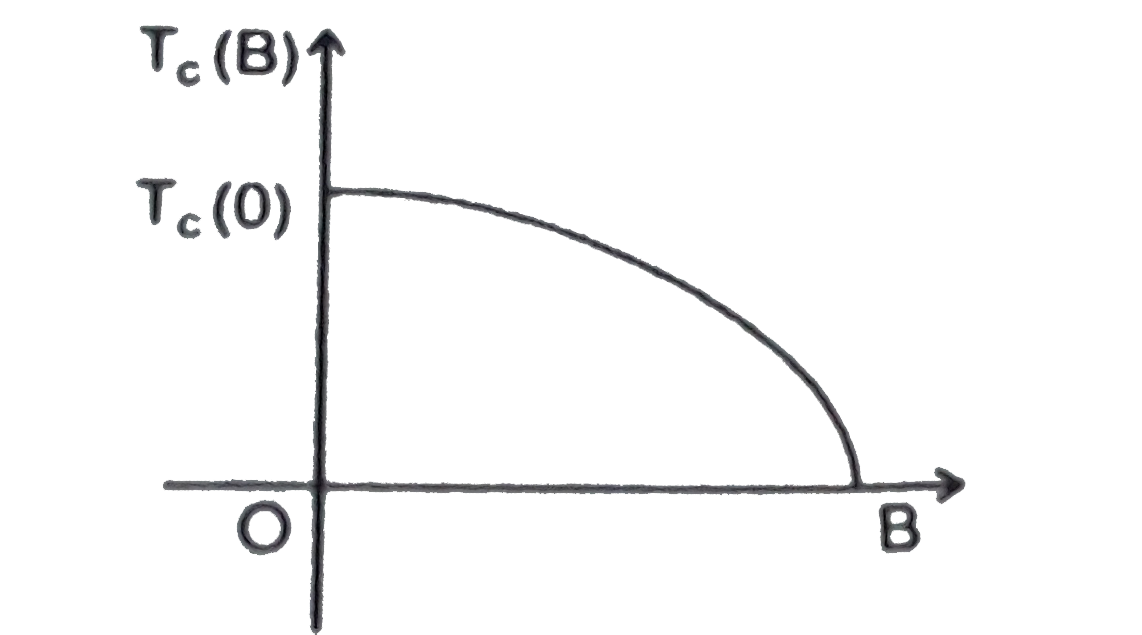
A superconductor has TC(0)=100K. When a magnetic field of 7.5 Tesla is applied , its TC decreases to 75 . For this material one can definitely say that when :
View Solutionकिसी पदार्थ का प्रतिरोध, जो कि अतिचालक है, इसका ताप क्रांतिक ताप TC(0) से कम करने पर अचानक अशून्य मान से शून्य तक परिवर्तित हो जाता है।
अतिचालक का एक रूचिकर गुण यह है कि यदि इन्हें चुम्बकीय क्षेत्र में रखा जाय तब, इनका क्रांतिक ताप TC(0) से घटने लगता है, अर्थात् क्रांतिक ताप TC(B), चुम्बकीय क्षेत्र की तीव्रता B का फलन होता है। TC(B) की B पर निर्भरता चित्र में प्रदर्शित है।

नीचे दिये गये ग्राफ में, दो भिन्न मान के चुम्बकीय क्षेत्रों B1 (सरल रेखा) तथा B2 (बिन्दुवत रेखा) के लिये अतिचालक के प्रतिरोध R को इसके ताप के फलन के रूप में दिखाया गया है। यदि B2 का मान B1 से बड़ा है तब इन चुम्बकीय क्षेत्रों में कौनसा ग्राफ R में T के साथ उचित परिवर्तन प्रदर्शित करता है
View SolutionA solid whose temperature t_(1)^(0)C It has a zero temperature chamber whose temperature t_(2)""^(@)C(t_(2) gt gt t_(1)) Is placed in. The rate of heat absorption by the body will be proportional
View SolutionThe alternate discs of iron and carbon, having same area of cross-section are cemented together to make a cylinder whose temperature coefficient of resistivity is zero. The change in temperature in two alternate discs is same. The ratio of their thickness and ratio of heat produced in them is found out. The resistivity of iron and carbon at 20∘C are 1×10−7and3×10−5Ωm and their temperature coefficient of resistance are 5×10−3∘Cand−7.5×10−4∘C, respectively, Thermal expansion is neglected. Here, △R1+△R2=0 (where △R1,and△R2, are the increase in resistances of iron and carbon, respectively, with the rise in temperature) because combined temperature coefficient of resistivity is given as zero.
A copper wire is stretched to make it 1% longer. The percentage change in its resistance is Electrical resistance of certain materials, known as super conductors changes abruptly from a non zero value to zero as their temperture is lowered below a critical temperature Tc(0) An interesting property of superconductors is that their critical temperature becomes smaller than Tc(0) if they are placed in a magnetic field, that is, the critical temperature Tc(B) is a function of the magnetic field strength B. The dependence of Tc(P) on magnetic field is shown in the below figure.
View SolutionElectrical resistance of certain materials, known as superconductors , changes abruptly from a non-zero value to zero as their temperature is lowered below a critical temperature T_c (0) An interesting property of superconductors is that their critical temperature becomes smaller than T_c (0) if they are placed in a magnetic field, that is, the critical temperature T_c (B) is a function of the magnetic field strength B. The dependence of T_c(B) on magnetic field is shown in the below figure . A superconductor has T_(c)(0)=100K . When a magnetic field of 7.5T is applied, its T_(c) decreases to 75K. For this material, one can definetly say that when
View SolutionElectrical resistance of certain materials, known as superconductors, changes abruptly from a nonzero value of zero as their temperature is lowered below a critical temperature TC(0). An interesting property of super conductors is that their critical temperature becomes smaller than TC(0) if they are placed in a magnetic field, i.e., the critical temperature TC(B) is a function of the magnetic field strength B. The dependence of TC(B) on B is shown in the figure.
 .
.
In the graphs below, the resistance R of a superconductor is shown as a function of its temperature T for two different magnetic fields B1(solid line) and B2 (dashed line). If B2 is larget than B1 which of the following graphs shows the correct variation of R with T in these fields?
View Solution